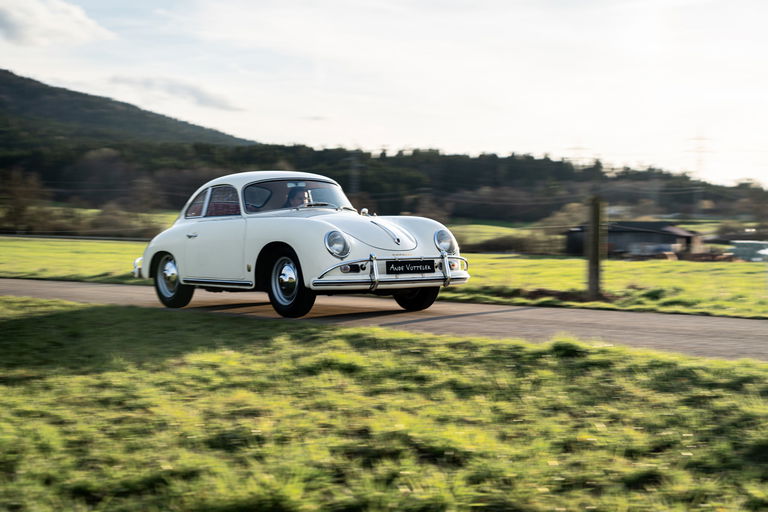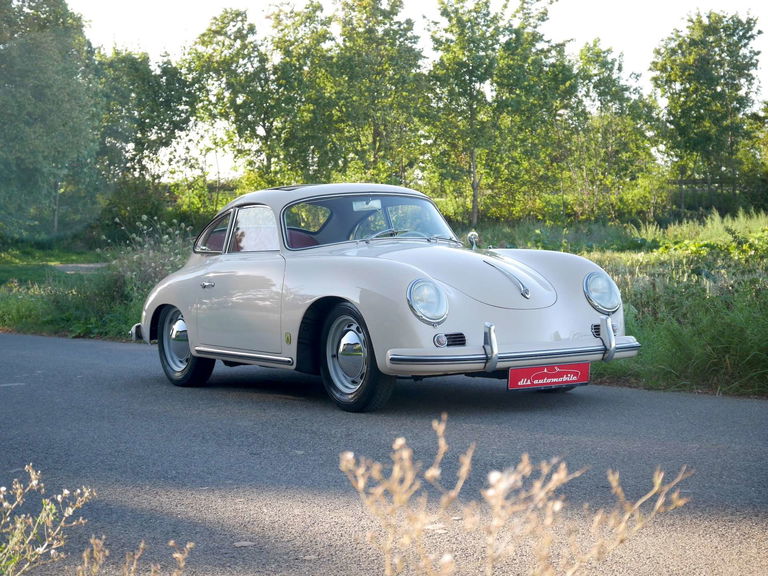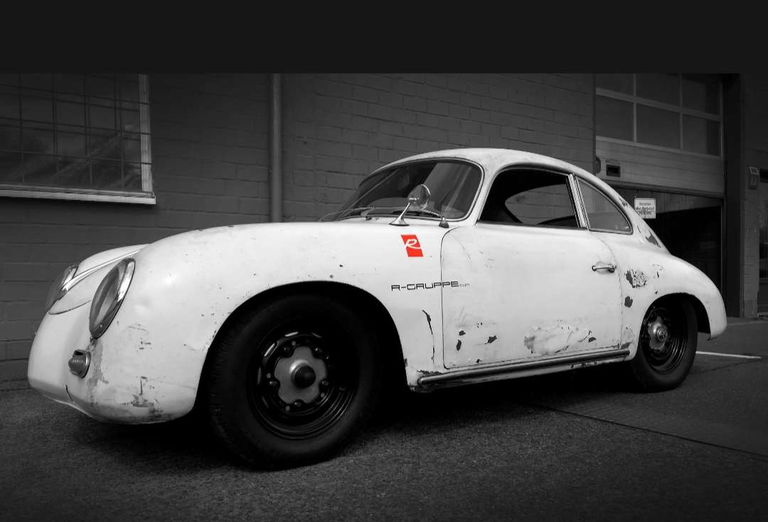If you sit in this Porsche 356, there is also the fact that the 75 hp are enough for great driving fun. It was like that in the fifties, and it will never change.
75 hp, from zero to 100 km / h in 14.5 seconds and at full throttle just 175 km / h – normally you can't lure a Porsche fan behind the stove with such key data. Because even the smallest Boxster has 300 hp, takes less than a third of the time to sprint to 100 km / h and is 100 km / h faster.
It is also these curves that are legendary to this day and spark the automotive passion to own and want to drive a 356.
Because as soon as you sit at the wheel of this classic and the air-cooled boxer babbles in the rear, you feel the same fire that burns in every Porsche to this day.
The ignition key is still to the right of the steering wheel here, and at less than four meters, the 1958 356 A doesn't look like a real sports car at first glance.
But as soon as the first gear clicks into the gearbox and the clutch snaps shut, you know what has struck the hour: the four-cylinder engine revolves willingly and shakes off a decade with every gas surge. The engine greedily hangs on the gas, and the 850 kg light-weight 356 shoots forward poisonously.
It feels agile, bright and incredibly authentic and much more puristic than the most exclusive GT model from modern times. This is not so much because of the simple equipment, but above all because there is nothing that could impair the proximity between the driver and the vehicle. No control unit, no servo pump – nothing distorts the direct, direct implementation of the driver's will.
With this vehicle, a collector and driver not only acquire a piece of automotive history, but also an excellent specimen due to the professional and careful restoration, which is both stable and reliable and guarantees driving pleasure for the next decades. For me there is no better way to enjoy the zeitgeist of that era!
Porsche 356 A 1600 Coupe / vehicle identity number 104057
This Porsche 356 with the vehicle identity number 104057 was first registered on December 31, 1958. The vehicle identification number / chassis number confirms the production as a coupe of the model 356 A T2 (number range 102505-104659). According to the Porsche delivery confirmation, the car was completed or delivered on June 26, 1958. The importer Max Hoffmann then exported to the USA.
Condition description / classification
It is a vehicle restored about 10 years ago, in which the interior shows the slight optical signs of use since its revision in the form of a pleasant patina. The technology has been revised.
The substance of the vehicle is healthy; visible accidental or corrosion damage could not be ascertained as part of the inspection.
The body with the Reuter body number 104057 stamped on the shield on the A-pillar is in good condition, the planking is smooth, the air gaps are even, the adjustment of the doors to the body is very good to good. Among other things, the original hood stamped with the number 057 was used.
The paintwork was renewed as part of the restoration. The measured layer thickness of the paint structure is mostly in the range of 500 to 1,300 µm, only in the lower area of the front fenders was there a lens in which the material thicknesses of 1.6 mm were slightly exceeded.
The surface and degree of gloss are mostly good, only the paint on the front edge of the trunk lid is minimal. Orange peel effects, runners or significant inclusions are not evident.
The surfaces of the attachments are mostly of good quality, defects are not apparent.
The exterior of the car comes in silver with a red leather interior, dark gray carpet and white headlining (according to Porsche delivery confirmation, the vehicle was originally delivered in light ivory).
The engine number read is P 82094. According to the literature, engine number P 82094 can be assigned to a 1600 S engine (type 616/2) of model year 1958 (number range 81522 to 82454).
The gearbox number is 12951, it is the optically suitable gearbox for this vehicle. This Porsche delivery certificate confirms the type 644 gearbox.
The following documents are available on the history of the vehicle:
A 2010 Certificate of Title from the State of California attested the ownership by the Lou and David Wxxx couple, Palo Alto CA 94306-1303. The same address can also be found in the Registration Card from 2001, so it can be assumed that this family owned the car for a long time.
An original invoice for a vehicle transport shows the arrival of the car in England on July 26th, 2004. Mr. Matt Wxxx, Leicester is named as the importer on this letter, as is the same date in the tax form.
In a copy of the UK Registration Certificate, 03/03/2007 is the date for the transfer of ownership to Mr. Paolo Sxxx, 79189 Bad Krozingen.
In the years 2010-2011, the vehicle was completely restored by "Dennis Nachtigal Classic Sports Car Husum", a specialist company specializing in the 356 model, and delivered on June 6, 2011 to the client and previous owner, who comes from the Frankfurt area. Since then, the vehicle has been in a collection geared towards particularly early 356 and 911 models and is now being offered for the first time due to a generation change.
Illustrated documentation is available, as is the opinion of the Ing.Office Wilhelm from 2017, which gives the rating 2+ and a market value of € 145,000.
Special equipment
– Blaupunkt “Frankfurt” radio with Redtip Hirschmann antenna
– 5 1/2 x 15 ″ chrome rims / tires Hankcook DOT 2018
– Aero mirror
– Ivory colored steering wheel
– Red leather upholstery
– Special painting metallic effect
– Export bumpers with brackets
– 55kw engine
– Tool kit
– hinged window
– 12V electrical system
Model history
Porsche 356
In 1947, Ferry Porsche began to design and manufacture a sports two-seater based on the mechanics of the Volkswagen. This was the birth of the legendary Type 356, the first vehicle with the “Porsche” trademark. Initially built as a one-off in Gmünd, series production began in 1950 after moving to Stuttgart-Zuffenhausen.
The production of the coupe and cabriolet bodies was initially carried out by the Reutter company. In the summer of 1952, the old, divided front window was replaced by a one-piece, bent panorama window. The range of engines for the articulated models started at 1100 cc with 40 hp, two 1300 cc engines with 44 and 60 hp, 1500 cc engine with 60 hp; the most powerful engine was the 1500 S, which produced 70 hp.
In 1955, the technically and body-wise developed model 356 A Tl appeared, which mainly differed visually from its predecessor by the kink-free panoramic windscreen and was built until 1957. The model range now ran from 1300 cc with 44 hp to the 1300 Super and 1600, both of which had 60 hp, to the 1600 Super with 75 hp. The 356 A Tl was available as a Coupe, Cabriolet and Speedster.
The Carrera engine, an elaborate sports engine with 4 camshafts and vertical shaft drive and dual ignition, has also been available since 1955 and initially has 1500 cc with 100 or 110 hp, making the 356 200 km / h fast. However, the 356 A Carrera models were around DM 5,800 more expensive than the basic model.
The 10,000th Porsche was built on March 16, 1956. Much of the success was due to Porsche Max Hoffman and his commitment to the American market, which accounted for approximately 50% of total sales. As early as 1953, Hoffman called for a basic model for the American market that should be available for less than $ 3,000. Ernst Kommenda then sat down with his employees and considered how such a vehicle could be realized. From September 1954, the range was therefore enriched with the "Speedster" version, an inexpensive, sporty and lighter convertible variant that was only available with the 1500 cc engines. The Speedster was offered in America for $ 2,995.
In autumn 1957, the 356 A T2 series introduced further improvements in series production, such as shortening the shifting distance, improved steering and clutch. The T2 series is visually recognizable by the teardrop-shaped taillights and exhaust tailpipes, which now end in the bumper horns. According to the literature, the teardrop-shaped taillights are said to have been installed in model Tl A as early as March 1957. The engine range is reduced to the 1.6 liter bumper engines with 60 or 75 HP. In addition to the Coupe, Cabriolet and Speedster versions, the "Convertible D", an open version manufactured by the Drauz body shop, was also added in terms of price and equipment between the puristic Speedster and the luxurious Cabriolet.
The Cabriolet built in parallel to the Speedster cost DM 15,000 in 1957 (model A T2) with the same engine, DM 2,000 more, and was significantly more luxurious.
In 1959, the Type 356 B T5 was introduced at the Frankfurt Motor Show, which implemented profound body modifications that became necessary due to new American regulations. The bumpers are set higher, the front headlights are now at the top of the fenders to better illuminate the road, the brake system is reinforced by aluminum brake drums with cooling fins and the transmission is optimized with improved synchronization and shorter shifting distances. A new black steering wheel with a countersunk hub and black control buttons, switches and levers were used in the interior, and the seats and seating position were further improved. The engine range is expanded to include the 1600 Super 90; There are now four engine variants, each with around 1,600 cc, for the 356 B T5: 60 hp (“lady”) as the basis, the super with 75 hp, the super 90 with 90 hp and the Carrera variants with 105-135 hp . There are also changes to the body variants: in addition to the Reutter coupe with a hatchback, due to the great demand at Karmann, a hardtop coupe is being produced, the cabriolet continues to be offered in a facelifted version, the Speedster is no longer available and the Convertible D becomes the Roadster that is manufactured at Drauz, among others.
In the summer of 1961, the next facelift was in the form of the 356 B T6, which had no major changes to the engine, power transmission and chassis. For this purpose, a number of changes were made to the body: the front and rear windows were enlarged; the rear and trunk lids have been enlarged, the tank opening has been moved to the right fender to make filling easier, the rear window should be kept clear by direct warm air supply.
With the model 356 C, which was presented in September 1963, the last model update came before the adjustment. In the engine variants, the "Dame" with 60 HP was not available, so – in addition to the Carrera engines – 2 variants with around 1600 ccm, the "C" with 75 HP and the "SC" with 95 HP were available. The roadster was omitted from the body versions; There were hardly any changes to the coupe and cabriolet. The most important model maintenance measure was the introduction of the new brake system, which had 4 Ate disc brakes and was clearly superior to the drum brakes in terms of braking performance and response.
The exterior of the Porsche 356 C is hardly distinguishable from the 356 B except for the engine cover, which is divided in the middle of the C. Only the changed rims with wheel covers are striking, due to the disc brakes now standard on all models.
Production of the Porsche 356 was discontinued in 1965. A total of 79,218 Porsche 356 were built from 1948 to 1966, 50 of them in Gmünd. The last 10 vehicles were 356 C Cabriolets for the Dutch police and were made in 1966.
According to literature, a total of 16,668 pieces of the Porsche 356 C were manufactured from July 1963 to April 1965, of which approx. 3,165 pieces were 356 SC (convertible or coupe). The new price of a 356 1600 C convertible was DM 15,950, that of a 356 1600 SC convertible DM 17,450.
Sources: Achim Kubiak: ,, Fascination 356 ″ Delius Klasing Verlag 2002; Dr. Brett Johnson: "Do 356 Porsche" Beeman Jorgenson 1990; Meredith / Isaac: “Porsche 3 56 ″, Heel-Verlag 1999; Dirk-Michael Conradt: ,, Porsche 3 56 ″ Motorbuch Verlag 1989
Porsche 356 A Coupe
From October 1955 to September 1959, the A-model of the Porsche 356 was initially built in the body versions Coupe, Cabriolet and Speedster. In 1958 the roadster variant "Cabrio D" of the body shop Drauz was added.
At the beginning of the 356 A series there were five engine types in the range: a 1,300 cc engine with 44 HP, the 1300 S with 60 HP, the 1600 with 60 HP, the 1600 S with 75 HP and the 1500 GS “Carrera” with 100 HP . All types of crankcase, cylinder head and piston were made of light metal.
The 1,300 cm3 engines with a smaller displacement were discontinued during the course of the construction period and were no longer part of the program for model year 1958.



















































































